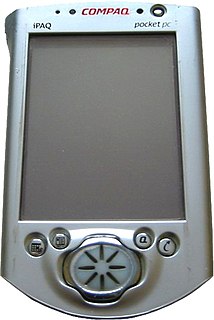
A Pocket PC is a class of personal digital assistant (PDA) that runs the Windows Mobile or Windows Embedded Compact operating system that has some of the abilities of modern desktop PCs. The name was introduced by Microsoft in 2000 as a rebranding of the Palm-size PC category. Some of these devices also had integrated phone and data capabilities, which were called Pocket PC Phone Edition or simply "Smartphone".
Windows Embedded Compact, formerly Windows Embedded CE, Windows Powered and Windows CE, is an operating system subfamily developed by Microsoft as part of its Windows Embedded family of products.

In computing, Virtual Network Computing (VNC) is a graphical desktop-sharing system that uses the Remote Frame Buffer protocol (RFB) to remotely control another computer. It transmits the keyboard and mouse input from one computer to another, relaying the graphical-screen updates, over a network.
In computing, TightVNC is a free and open-source remote desktop software server and client application for Linux and Windows. A server for macOS is available under a commercial source code license only, without SDK or binary version provided. Constantin Kaplinsky developed TightVNC, using and extending the RFB protocol of Virtual Network Computing (VNC) to allow end-users to control another computer's screen remotely.
RealVNC is a company that provides remote access software. The software consists of a server and client application for the Virtual Network Computing (VNC) protocol to control another computer's screen remotely.
RFB is an open simple protocol for remote access to graphical user interfaces. Because it works at the framebuffer level it is applicable to all windowing systems and applications, including Microsoft Windows, macOS and the X Window System. RFB is the protocol used in Virtual Network Computing (VNC) and its derivatives.

Windows Mobile is a discontinued family of mobile operating systems developed by Microsoft for smartphones and personal digital assistants.
Remote administration refers to any method of controlling a computer from a remote location. Software that allows remote administration is becoming increasingly common and is often used when it is difficult or impractical to be physically near a system in order to use it. A remote location may refer to a computer in the next room or one on the other side of the world. It may also refer to both legal and illegal remote administration.

A handheld PC is a miniature computer typically built around a clamshell form factor and is significantly smaller than any standard laptop computer, but based on the same principles. It is sometimes referred to as a palmtop computer, not to be confused with Palmtop PC which was a name used mainly by Hewlett-Packard.

Internet Explorer Mobile is a discontinued mobile browser developed by Microsoft, based on versions of the Trident layout engine. IE Mobile comes loaded by default with Windows Phone and Windows CE. Later versions of Internet Explorer Mobile are based on the desktop version of Internet Explorer. Older versions however, called Pocket Internet Explorer, are not based on the same layout engine.
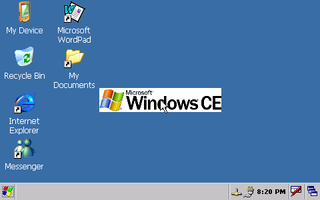
Windows CE 5.0 is a successor to Windows CE 4.2, the third release in the Windows CE .NET family. It was first released on July 9, 2004. Like its predecessors, Windows CE 5.0 is marketed towards the embedded device market and independent device vendors. Windows CE 5.0 is billed as a low-cost, compact, fast-to-market, real-time operating system available for x86, ARM, MIPS, and SuperH microprocessor-based systems.
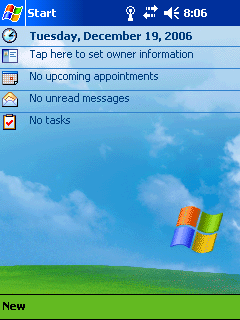
Windows Mobile 2003, originally codenamed "Ozone", is a discontinued mobile operating system and member of the Windows Mobile family. It was released on June 23, 2003, and was the first Microsoft OS to be called "Windows Mobile". It was based on Windows CE 4.20.

The Jornada was a line of personal digital assistants or PDAs manufactured by Hewlett-Packard. The Jornada was a broad product line that included Palm-Size PCs, Handheld PCs, and Pocket PCs. The first model was the 820, released in 1998, and the last was the 928 model in 2002 when Compaq and HP merged. The Jornada line was then succeeded by the more popular iPAQ model PDAs. All Jornada models ran Microsoft Operating Systems that were based on Windows CE.

UltraVNC is an open-source remote-administration/remote-desktop-software utility. The client supports Microsoft Windows and Linux but the server only supports Windows. It uses the VNC protocol to control/access another computer remotely over a network connection.
Desktop sharing is a common name for technologies and products that allow remote access and remote collaboration on a person's computer desktop through a graphical terminal emulator.
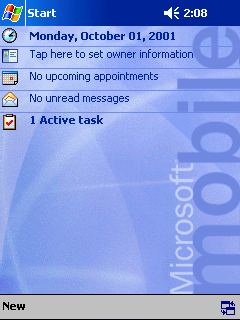
Pocket PC 2002, originally codenamed "Merlin", was released on October 4, 2001. Like Pocket PC 2000, it was powered by Windows CE 3.0. Although targeted mainly for 240×320 (QVGA) Pocket PC devices, Pocket PC 2002 was also used for Pocket PC phones, and for the first time, smartphones. These Pocket PC 2002 Smartphones were mainly GSM devices. With future releases, the Pocket PC and Smartphone lines would increasingly collide as the licensing terms were relaxed allowing OEMs to take advantage of more innovative, individual design ideas.
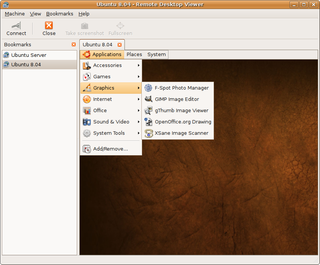
Vinagre is a VNC, SSH, RDP and SPICE client for the GNOME desktop environment. It was included in GNOME 2.22. It has several features, like the ability to connect to multiple servers simultaneously and to switch between them using tabs, VNC servers browsing and bookmarking. In version 2.29, Vinagre added controlling frame compression, better scaling and color depth. Version 2.30 added improved SSH tunneling and better support for copy/paste features between client and server.

Pocket PC 2000, originally codenamed "Rapier", was released on April 19, 2000, and was based on Windows CE 3.0. It was the debut of what was later dubbed the Windows Mobile operating system, and meant to be a successor to the operating system aboard Palm-Size PCs. Backwards compatibility was retained with such Palm-Size PC applications. Pocket PC 2000 was intended mainly for Pocket PC devices, however several Palm-Size PC devices had the ability to be updated also. Further, several Pocket PC 2000 phones were released, however Microsoft's "Smartphone" hardware platform was not yet created. The only resolution supported by this release was 240 x 320 (QVGA). Removable storage card formats that were supported were CompactFlash and MultiMediaCard. At this time Pocket PC devices had not been standardized with a specific CPU architecture. As a result, Pocket PC 2000 was released on multiple CPU architectures; SH-3, MIPS, and ARM. Infrared (IR) File beaming capability was among the original hardware features.








